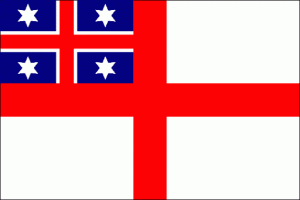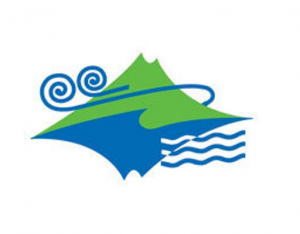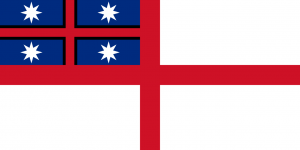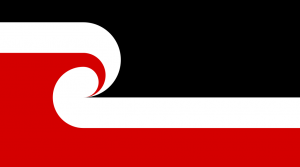The Christchurch City Council (CCC) and the Okains Bay Māori and Colonial Museum held their 45th Waitangi Day celebration with a citizenship ceremony at Opara (Okains Bay), Banks Peninsula, South Island. The Christchurch City Council and the Okains Bay Māori and Colonial Museum chose to ignore flying the national Māori flag recognised by the New Zealand Government on Waitangi Day (see below for Flag details).
Instead, an unauthorized and unrecognized version of the Māori United Tribes flag was flown (see below). It is not the flag that Māori fly at Waitangi day and other protests around the country.

The Independence flag flown by the Christchurch City Council ignored the Māori designed flag and chose the government approved flag design, further showing a cultural ignorance of Māori and Treaty relationships on Waitangi day. The impact is that over 47 individuals who gained citizenship on Waitangi Day 2020 and the large amount of new citizens friends, families and support people, will have the wrong idea about the appropriate flag.
The manawhenua/ haukāinga of Opara (Okains Bay) are Ngāti Huikai; a hapū of the dominant south Island Tribe Ngāi Tahu. Neither Ngāti Huikai, nor Ngāi Tahu or any of its hapū and rūnanga were signatories to the He Whakaputanga – Declaration of Independence. Though Southern iwi were invited to be signatories, they did not.
Ngāi Tahu (see below) have their own flag with the corporate logo. This flag was not flown either.

The correct Māori Independent Flag (see below) represents the Northern tribes of the North Island who signed He Whakaputanga – Declaration of Independence. It does not represent the South Island iwi Ngāi Tahu who were hosting the Waitangi Day event.

The original flag design was chosen in March 1834 by the twenty-five Maori chiefs. The flag flown by the council and , was the design that was gazetted in New South Wales on 19 August 1835 where the description omitted the black fimbriation, substituting white instead, and made the stars six point instead of eight point. The mistake, did not invalidate the chief’s selection, but the error is still being perpetuated by some organisations today showing a lack of respect to Māori.
Ngāti Huikai and Ngāi Tahu whānau did fly the national Māori flag on their own legally recognised land across from the main celebrations. In this area there was a large contingent of Ngāi Tahu preparing a hangi for the celebration of the day.
History of the ‘first official’ designed flag by Te Ngāi Tūāhuriri
May 31 – June 1, marked the 104th anniversary of the Battle of Jutland, the largest naval battle of the First World War. It was the only time in the Great War that the entire fleets of both Britain and Germany met in battle.
HMS New Zealand was one of three Indefatigable-class battle cruisers in the fight, built for the defense of the British Empire but paid for by the New Zealand Government. The Ship received many taonga from Iwi all over the country including a Māori ensign from Tuahiwi, North Canterbury.
The flag was based on the New Zealand’s 1834 first official flag the United Tribes. Two flags were commissioned by the people of Tuahiwi one was gifted to the H.M.S. New Zealand and the other to the Pioneer Māori Battalion.
When the HMS New Zealand went into action at the Battle of Jutland, the commanding officer as promised to the Chiefs of new Zealand, evoked the protection of Atua Māori, he hoisted the Tuahiwi Ensign and put on a piupiu and greenstone hei tiki.
During the war, HMS New Zealand took part in several significant battles, although the ship came under heavy fire, it was never hit and the Māori taonga were considered good omens by Captains and crew alike. After the war Sir John Jellicoe, Admiral of the British Fleet sent the following “ To the Maoris of Tuahiwi and Kaiapoi the Navy will ever remember that your flag was flown aboard at the battle of Jutland”.
Other culturally inappropriate behavior
The publication distributed by the Christchurch City Council ignored manawhenua and instead wrote a history of the Iwi Ngāi Tahu. There was no consultation with the manawhenua who have their primary pā and are still resident in the Port Levy Bay for for hundreds of years. The city of Christchurch is named after the famous ancestor of Ngāti Huikai, Tautahi. Otautahi is so named because Tautahi’s pā covered much of the city center and he is buried within the four avenues of the city.
During the pōwhiri there was chaos with no guidance to the visitors who crossed the atea and joined manawhenua. There was also no kaikaranga to reply to the manawhenua kaikaranga and multiple other cultural issues.
Lessons to be learnt
Considerations to the ongoing impacts of the Tohunga Suppression Act 1907 that are still evident today with many Māori not knowing their culture. It should never be assumed that a Māori staff member or a friend who is Māori is knowledgeable about Māori culture. The same advise applies to someone who speaks Māori: it does not mean that they are culturally aware. Māori language is now taught in classrooms and from books. Culture is learnt by being immersed in they physical, mental and spiritual daily activities and rituals.
Consulting with the local marae and manawhenua is essential and ensuring you are speaking with someone in a recognised position of authority at the marae. An elderly grey haired person is not necessarily a kaumatua in todays modern society.
The Māori Flag

This is a copy of a written post by Hone Harawira.
Waitangi 2020, marks 30 years since the Māori flag was launched at ‘Hikoi ki Waitangi 1990’. The Māori flag is a symbol of Māori liberation & identity.
HOW DID THE FLAG COME ABOUT?
The Māori flag was inspired when members of Te Kawariki; Hone Harawira, Hilda Halkyard-Harawira and Ripeka Evans traveled to Australia at the invitation of Tiga Bayles and Maureen Watson, to stand in solidarity with our Aboriginal brothers & sisters opposing the Commonwealth games.
The Aboriginal flag was graffitied everywhere – on the footpath, on cars, shop windows, walls, power poles – a reminder to all those attending the games, whose whenua they were standing on. There was no facebook at that time so the flag was ‘a call to action’ for Aboriginal people to connect in their collective identity and unite in their struggle.
In 1989, Govt allocated $30 million to celebrate 150 years since the signing of the Treaty, to prepare for the Queens visit to Aotearoa and to ‘hush the murmurs of discontent’.
In response, Te Kotahitanga (collective of Kaupapa Māori activist groups groups from around Aotearoa) met to discuss creative ways to raise awareness about Treaty injustices and ongoing legislative abuses to Māori. These included exhibitions, whakaari, hui waiata, treaty workshops etc.
Te Kawariki (a movement from Tai Tokerau) initiated a Māori flag competition. The competition was promoted through Māori radio stations and underground movement networks – hui, newsletters, word of mouth etc. Te Kawariki received a large number of entries but weren’t satisfied with the designs submitted so the kaupapa was taken back to Marae around Tai Tokerau for consultation.
The winning design was created by our Aunties from within Te Kawariki including the late Jan Dobson of Patuharakeke, the late Hiraina Marsden of Ngai Takoto, and Linda Munn of Ngāti Manu and Tauranga Moana. Aunty Liz Marsden of Ngai Takoto, Ngāti Korokoro and Te Whānau ā Apanui contributed to the alignment of the flag and Uncle Pou Erstich of Ngai Takoto put the whakamāramatanga to it.
The first flag was hand stitched by Aunty Linda’s Mother-in-law. Our Whangarei whānau screen printed the first t-shirts and our Tauiwi comrades from the Association for Independent Aotearoa subsidised the first editions of the poster.
WHAT DO THE COLORS OF THE FLAG REPRESENT?
Black – represents Te Korekore, the realm of Potential Being. It represents the long darkness from whence the world emerged. It represents the heavens. The male element is formless, floating and passive.
White – represents Te Ao Marama, the realm of Being and Light. It is the Physical World. White also symbolises purity, harmony, enlightenment, and balance.
Koru – the curling frond shape, the Koru, represents the unfolding of new life. It represents rebirth and continuity, and offers the promise of renewal and hope for the future.
Red – represents Te Whei Ao, the realm of Coming into Being. It symbolises the female element. It also represents active, flashing, southern, falling, emergence, forest, land and gestation. Red is Papatuanuku, the Earth Mother, the sustainer of all living things. Red is the colour of earth from which the first human was made.
The design represents the balance of natural forces with each other. To live life is to live with nature. To appreciate life is to understand nature.
HOW DID IT BECOME A NATIONAL FLAG?
Through hui and actions all throughout the country, the Māori flag was embraced by activists, Kaumatua, communities. It’s simple design was made popular through nationally televised events – news, international sporting events, cultural ceremonies etc. For those living or travelling abroad, it was a way to identify as being Māori.
In 2009, Te Puni Kokiri hosted a series of consultation hui asking people to vote on a flag to fly alongside the NZ Union Jack at national events of significance. 80% of submissions received voted in favour of the Māori flag
Although the Māori flag is recognised as a national flag, ehara te kara i raro i te mana o te Kawanatanga.
WHAT’S THE DEAL WHEN USING THE FLAG?
Te Kawariki set down some tikanga when using the flag:-
1) Don’t change the dimensions or colours – it loses its essence
2) Don’t wear it around your nono
3) The symbol can be used for any kaupapa that promotes, encourages and supports Te Ao Māori and should not be used or sold for personal gain.
Proceeds from sales of the Māori flag have contributed to a number of initiatives across the country, including the establishment of Kōhanga Reo, Kura Kaupapa, Whare Wānanga, Marae, Decolonisation hui, Māori health and wellbeing initiatives, environmental research, marches and occupations, developing educational resources, supporting young people through tertiary studies etc.
WHO OWNS THE FLAG?
Nā Te Kawariki i whakatakoto te kaupapa
Nā Te Kawariki hoki te rawa taunaki
Ahakoa kua tākohangia hei taonga mō te Ao Māori,
Ko Te Kawariki ngā kaitiaki o te kara Māori
A number of people have claimed ownership and/or rights to the flag but kia mohio mai tātou – the flag does not belong to any one Individual, Whānau, Iwi, Company, Organisation, Religion or Political Party!
The birth of the Māori flag was inspired by a collective vision and a need for symbol to express our united struggle, the motivation was upheld and fueled by the strength of the relationships built over many years and was developed through a series of wānanga, consultation and hui, inspired by tohu from our taiao.
WHAT CAN WE DO TO PROTECT THE FLAG?
Fly your kara high e hoa mā. Fly it with pride.
Wear it with pride.
Educate to liberate. Tell your children and your Mokopuna what it represents.
Don’t use it as a tool to incite hate or whakaiti each other.
Finally, but most importantly, kia ū ki te kaupapa o te kara. Stay true to the kaupapa of the flag!!!!
……..
He karanga tenei ki ngā mema o Te Kawariki, ngā whānau hoki o ngā kai toi o te kara, kia wānanga ai tātou i ngā whakaritenga mō te kara.
Me Whakapakari ki te hua o te Kawariki e.
Te Whenua.
As told to me by my Parents, Aunties and Uncles.

Leave a Reply